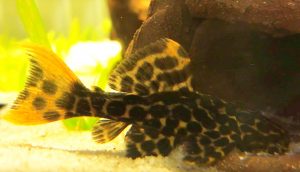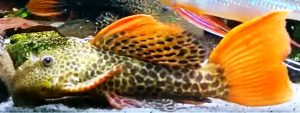The Leopard Cactus Pleco L-114 (Pseudocanthicus leopardus) is also known to tropical fish keeping enthusiasts as the Demini Pleco, Redtail Leopard Plecostomus, or Leopard Acanthicus and is found in the rio Demini, a northern tributary in the rio Negro basin in the Amazonas state of Brazil.
Leopard Cactus Plecos have also been tentatively identified in the Rupununi River in Guyana.
The Leopard Cactus Pleco has a light tan to yellowish brown body covered with dark brown to black spots that cover the entire body and fins. The fins develop into a bright red to red-orange color that fades as the fish grow older.
Juvenile Leopard Cactus Plecos have a yellowish coloration that fades as they mature. Some color variation exist between individuals, with age, and by geographic locale.
Adult males have a slimmer body, a broader head, more pointed fins, and more extensive odontode development than females, particularly on the leading pectoral fin rays.
The Leopard Cactus Pleco is occasionally confused with Pseudacanthicus leopardus L600/LDA73 which is found in the Rio Branco, in Brazil and grows to 12″ in length.
The Leopard Cactus Pleco is a relative peaceful species that become more aggressive and territorial as they mature, especially to conspecifics.
Leopard Cactus Plecos should be housed in at least a 70 gallon aquarium with a dark sand or fine gravel substrate, some rocky caves, PVC piping, driftwood or bogwood
for them to hide among, and some floating plants
to diffuse overhead lighting.
Pseudocanthicus leopardus prefer a dimly lit aquarium with plenty of open space for them to move around. Because of their size, they need an excellent filtration system and regular water changes to maintain the high water quality they require to stay healthy.
Leopard Cactus Plecos are cave spawners that have reportedly been bred in an aquarium environment. The males take care of the offspring.
Although identified as an omnivore, the Leopard Cactus Pleco is a member of a genus of carnivorous pleco’s called Pseudacanthicus, or Cactus Pleco’s and is primarily a meat eater. In their natural habitat, they use their strong teeth to pry open snails, small crustaceans, and to grasp pieces of fish and worms from the bottom.
In an aquarium environment, they should be provided live, frozen, or freeze dried shrimp, mussels, worms, Daphnia, krill, pieces of fish, and similar meaty foods as their primary diet with some plant matter as a supplement. They are not predatory to other fish species.
Once acclimated to aquarium conditions, they will gradually accept omnivore and carnivore pellet foods and fresh vegetables in addition to their primary diet.
The Leopard Cactus Pleco L-114 is much more common than it’s more rare counterpart L-600 however, both are not common or readily available to tropical fish keeping enthusiasts. They can be found online on catfish forums, from tropical fish importers, and from specialty fish shops.
When available, the approximate purchase size is usually from 1-1/2″ to 2-1/2″ in length.
Minimum Tank Size: 70 gallons
Care Level: Moderate
Temperament: Peaceful
Aquarium Hardiness: Hardy
Water Conditions: 73.4-82.5°F, GH 4-13 ° , pH 5.5 – 7.2
Max. Size: 9.5″
Color Form: Black, Brown, Yellow
Diet: Omnivore
Compatibility: Good community tank
Origin: Brazil, Guyana
Family: Loricariidae
Life Span: 12 years
Aquarist Experience Level: Intermediate




One Response to “Leopard “Cactus” Pleco L-114 (LDA07) (Pseudocanthicus leopardus)”
Trackbacks/Pingbacks
[…] that become extremely boisterous and territorial as they become adults. They are very similar to L-114 which is found in the Rio Demini in Brazil, but grow larger and are more startling in […]